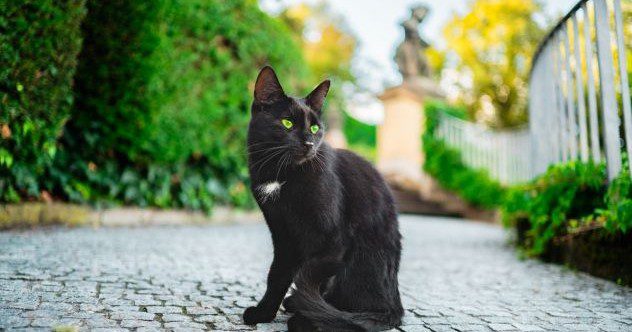It is often said that people should get out of their comfort zone if they want to dream up big new ideas, but maybe it all depends on where that comfort zone is. If it is one of the 45,000 or so pubs found across the British Isles, it might be better to stay put. These homey drinking establishments and social hubs have helped foster creativity in a wide range of fields. Here are ten impactful and interesting examples.
Related: 10 Ideas That Scare People to Death
10 Cat’s Eyes
From 1934 onward, the world’s roads became much safer thanks to a remarkably simple invention. Called “cat’s eyes,” these are small studs in the road that gently reflect drivers’ headlights at night, illuminating the shape of the road ahead. Weather-resistant, resilient, and requiring no power, it is no surprise that they were widely adopted around the world. However, they would never have existed were it not for a trip to a Yorkshire pub one foggy night.
The drive home from inventor Percy Shaw’s local pub was full of twists and turns. On that foggy night in 1934, Shaw narrowly avoided what could have been a fatal accident when his headlights were reflected by the eyes of a cat. After this eureka moment, he created a prototype, and by the 1960s, his company was making 2,000 cat’s eyes a day. Shaw became very rich in his lifetime, and he later had a pub named in his honor.[1]
9 Skyscanner
Percy Shaw is not the only person who has become rich due to a trip to his favorite watering hole. In more recent times, an Edinburgh-based entrepreneur called Gareth Williams dreamed up the flight-comparison platform Skyscanner during a brainstorming session with some friends in a pub. This took place in 2003 after Williams, a keen skier, grew frustrated with the need to check many websites to find cheap flights when he wanted to hit the slopes.
Those two friends, Barry Smith and Bonamy Grimes, would become his co-founders. The trio started with a simple spreadsheet, which soon became a prototype website with a search engine that compared flights from different airlines.
Later that year, the site had grown enough for the co-founders to run it full-time. Despite being some distance from Silicon Valley, Skyscanner became a true tech unicorn, being sold to a Chinese company for £1.4 billion in 2016.[2]
8 “The Secret of Life”
In February 1953, an excited man walked into an English pub called The Eagle and declared that he, along with a fellow named James Watson, had “found the secret of life.” Had this been announced at a drinking establishment anywhere else in the world, it probably would have been dismissed as the ravings of a madman. But in the university city of Cambridge, there might just be some truth to it. It turned out that there was.
That man was the scientist Francis Crick. The Eagle was the pub of choice for him, Watson, and the other scientists they worked with at the nearby Cavendish Laboratory. Crick was, of course, announcing the discovery of DNA’s double-helix structure. The official announcement was made in the journal Nature, and it would later earn Crick, Watson, and their fellow scientist Maurice Wilkins a Nobel Prize in 1962.[3]
7 Middle Earth and Narnia
The original name of Crick and Watson’s pub was The Eagle and Child, which was also the name of a famous pub in the rival university city of Oxford. However, this pub did not achieve fame because of its patrons’ great insights into the real world but because of their ability to create new worlds. The patrons in question are J.R.R. Tolkien and C.S. Lewis, two of the 20th century’s leading fantasy authors.
The pair could often be found tucked away in a section of the pub called the “Rabbit Room.” There, they would sit by the fireplace and puff away at pipes while sharing tales of Middle-earth and Narnia, the imaginary worlds where Tolkien’s Lord of the Rings and Lewis’s Chronicles of Narnia series would be set. Other academics from the university would also attend, and the group called themselves “The Inklings.”[4]
6 Robinson Crusoe and Treasure Island
The Eagle and Child pub dates all the way back to 1650, just a few years before another legendary literary pub opened in the city of Bristol in west England. The Llandoger Trow opened by the city’s harbor in 1664 and was named after a nearby village in Wales and a type of boat that the landlord, Captain Hawkins, used to sail. If this sounds like a scene from Treasure Island, there might be a reason for that.
Robert Louis Stevenson, the author of Treasure Island, is believed to have based the novel’s pub on the Llandoger Trow. It is even said that Blackbeard himself, who was born in the city, used to drink there. But the pub is also thought to have been where Daniel Defoe got the inspiration for his classic novel Robinson Crusoe. He reportedly met real-life castaway Alexander Selkirk there and modeled Crusoe on him.[5]
5 The Gunpowder Plot
Not all big ideas are successful, even if they are conceived in a pub. This was a lesson that Guy Fawkes and his co-conspirators found out the hard way. Still, they hold the rare distinction of having organized a spectacular failure that is celebrated every November in the UK. The now infamous Gunpowder Plot was the brainchild of a militant Catholic called Robert Catesby, who had tired of King James I’s lack of tolerance for Catholics.
In 1604, Catesby and other Catholics gathered in a pub called the Duck and Drake. There, they swore an oath of secrecy, which was no doubt required because they were plotting to kill the king by blowing him up during a visit to the Houses of Parliament. However, somebody could not keep the secret. Following a tip-off, a plotter called Guy Fawkes was caught beneath the building with gunpowder and matches. The gang was captured and brutally executed.[6]
4 D-Day
Other explosive pub-based plans have been more successful than the Gunpowder Plot. One notable example was finalized at a quaint countryside pub called the Bells of Peover in the spring of 1944. That is where, over meals on two consecutive days, Allied Supreme Commander Dwight Eisenhower and U.S. General George Patton put the finishing touches to their plans for the invasion of Normandy, a crucial step in liberating Europe from Nazi tyranny.
Patton’s troops had been based in the tiny village of Lower Peover since January of that year, and they trained for their deployment to France in the surrounding countryside. They must have trusted their leaders’ plans. One serviceman’s diary, discovered in the pub decades later, describes how the soldiers were excited for the D-Day landings on June 6. Today, the pub still flies a U.S. flag, and its dining room is known as “The Patton.”[7]
3 A Heartbreaking Ballad
Running a pub in modern times is much harder than it was in Patton’s day and earlier. Demographic changes, new entertainment options, and the adoption of a more health-conscious attitude among the public make pubs a tough business to be in today. However, one thing that is guaranteed to turn a pub’s fortunes around is being mentioned on a Taylor Swift album. And that is exactly what happened to a London pub called the Black Dog.
A bonus track on Swift’s 2024 album, The Tortured Poets Department, shares its name with the pub. The lyrics narrate a story of the singer tracking a former lover there and seeing them with a younger woman. Swift has some British ex-boyfriends, namely singer Matty Healy and actor Joe Alwyn. While dating the latter, she reportedly spent a lot of time in London, allowing fans to accurately guess the pub’s location.[8]
2 A Famous Cinematic Pub
Few pubs or bars in films have been as central to the plot as The Winchester in 2004’s Shaun of the Dead. It is where the unusual romantic comedy opens, with Simon Pegg’s Shaun being begged by his girlfriend not to spend every night there. When the zombie apocalypse strikes, Shaun’s plan is to save his loved ones and seek safety inside the pub, mirroring Pegg’s real-life zombie survival plan.
As young actors living in London, Pegg and his co-star Nick Frost would spend their free time in their local pub, The Shepherds. While there, they discussed plans for surviving a zombie apocalypse, with Pegg choosing the pub as his destination to hold out against the hordes. Their friend, the director Edgar Wright, turned the plan into the plot of the film and based The Winchester on The Shepherds, even giving the pub’s staff the same names.[9]
1 An Important Statistical Distribution
This last idea was actually conceived in a brewery, not a pub. However, the goal was to improve the drinks served in the latter. It just turned out to have a lot of applications besides that. The brewery is also no longer British, although it would have been at the time. The idea in question is William Sealy Gosset’s t-distribution, an important statistical tool that Gosset developed in 1908 while working at the Guinness brewery in Dublin.
Gosset’s inspiration came from another scientist who thought hops with more resin made better beer. However, they could not measure the resin of all the hops in a crop. They could only test small samples and had to make an educated guess about whether the whole crop had high or low resin or if only the ones they had picked out did. Gosset’s t-distribution brought rigor to this process and can be applied to many tests with small samples.[10]















